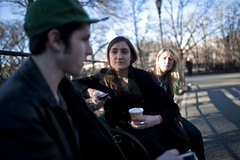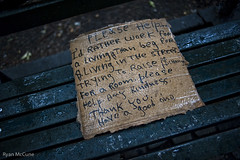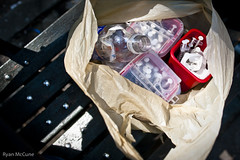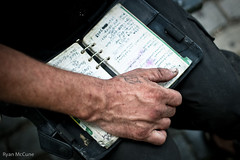Earlier today the Bowery Mission and Catholic Worker told us they were gearing up for an influx of homeless men and women seeking shelter from the storm. Andrea Stella started The Space at Tompkins in 2009, to serve “travelers” that were too old for the city’s youth drop-in centers and who normally don’t take advantage of adult shelters. She said many would be staying at squats or group apartments in Brooklyn tonight. “We got two people a motel room because they had nowhere to go,” she said. “There’s not too many people in town right now.”
Ms. Stella’s volunteer organization helps transient individuals secure a variety of goods and services, including mental health counseling, clean needles, GED prep, college counseling, cell phones, medical care, methadone, and food stamps. We asked her where “travelers” and “crusties” go during cold weather, and what the difference is between the two, anyway.
Where do the people you work with go in the winter?
Most people travel south or west, but the ones who stay are still on the streets. We’ve been able to move our PBJ dinner inside from Tompkins Square Park to Judson Memorial Church on Thursday nights (thank god they donated the room for free, it’s saving us). The people who stick around are mostly people who want to stay in New York, and it’s nice in the winter because without as many people, we can make some headway with individuals (like housing).
Can you give me some general background on the scene your most involved with? Are you working mostly downtown?
We’re “The Space at Tompkins” because when I started the organization, all of the travelers were hanging out in Tompkins Square Park, and it had been like that for years. One year in, there was a lot of heightened police presence and overwhelming community blacklash surrounding the travelers, and they were pretty much kicked out of Tompkins Square Park. Ever since then, we’ve been doing our work where we find people. Mostly lower Manhattan (East Village, Lower East Side, 23rd Street and Sixth Avenue), and we’ll head out to the squats in Brooklyn to do overdose trainings check up on everyone.
How many street kids are there downtown?
It varies by the season – but we probably see around 250 unduplicated kids a year. Some stick around for weeks, months, others come and go throughout the spring, summer and fall.
What’s the difference between home bums, street kids, travelers, crusties etc?
“Home bums” are the homeless folks who are lifers in one place. It can refer to the older homeless crowd that’s usually drinking on the south side of Tompkins Square Park, or used as an insult to a traveler if they’ve made roots in one place for too long and are still on the streets.
The definition of “street kids” is all over the place, but “street-homeless youth” is usually referring to LGBTQ kids who have been displaced because of their sexual orientation – that’s the dominant term in research.
“Travelers” — my crew — are the “kids” who find a way to go from city to city, state to state, sometimes on trains, definitely move around with the seasons. They usually leave home in their teens and then stay disconnected from mainstream society for years.
“Crusties,” or crust punks, look like the travelers, and sometimes you can be both, but they usually started out following the crust punk music scene.
The distinctions aren’t so obvious to outsiders, but are obvious w/in the community
Are opiates the drug of choice for street kids? Do you think we should legalize and regulate drugs like this?
My crew likes to party. Opiates are used, depending on supply — sometimes they are the drug of choice, sometimes alcohol prevails. We’re lucky in New York City because there’s really no crystal meth on the scene — and if people were tweaking all day, I swear we couldn’t do our work. But also — the worst, hands down, drug people take that makes our work almost impossible: alcohol. I’ve never felt threatened by anyone who’s high on dope (clearly because they’re nodding out) or even crack because they’re jumpy, but I’ve felt incredibly threatened by people completely demolished on Four Loko. They’ll turn on you at the drop of a dime. No other drug does that. (And I’m not judging — I’m a wino — I’m just pointing it out).
My focus isn’t the policy side or the legalization side of the drug debate. My focus is really just public health. How can we start to create a healthier community? There are so many factors involved in drug use, it’s impossible to solve any of it without looking at a person’s use (and it’s no accident that I’m not using the word abuse — part of the change in mindset starts with language) holistically. Our goal is to provide comprehensive services to individuals — on their timeline, not ours — and hopefully from that connection to us, they will start to see the healthier options for their use of any substance and the vast options for their lives (cheesy but it’s true). We should focus more on the person, not the substance they’re ingesting.
How many ODs would you say you’ve prevented?
From November until now, we’ve distributed 65 kits of Narcan, all of which have been used. There’s two vials to a kit, so sometimes they can be used to reverse two overdoses — I’d say in the last four months, there have been over 80 overdoses reversed because of our Narcan distribution. That’s a crazy number of lives saved.
What’s the city’s biggest issues?
The city doesn’t really care about my crew at a macro level. They’re not around long enough to access a lot of homeless services, and they represent an incredibly small number of the overall homeless population. On a community board level, residents make complaints a lot to Susan Stetzer about the behavior of the folks I work with. And I can’t say that they’re angels — in fact, most of them know damn well that they’re not angels when they’ve been drinking on a summer day and freak out in the middle of Second Avenue or something. But historically, trying to push a problem elsewhere (I’ve heard “send them to Brooklyn!” or “get them inside!”), or complaining without a plan for a solution has never fixed anything.
I started this organization as a response to a gap in services. I would love for more community members to contact us directly instead of the Community Board 3 staff when this crew is getting out of hand so that we can intervene instead of people who have no authority within the traveler community (I don’t mean in the legal sense, I mean from a respect standpoint; the kids respect us). We’ve spent years building relationships with the people we work with, and most of our staff came from the traveler community, so we’re happy to be that buffer.
How do you keep sane?
I’m a wino. And I do it because I love it and because I know that with a little less impulse control and a few different decisions, I could be in the exact same place as a lot of the kids I work with. I think we all (staff) understand that fine line intimately, which is why we’ve been able to continue this incredible labor of love, for free, for three years. Non-judgmental compassion, it’s a badass skill to cultivate and have.








